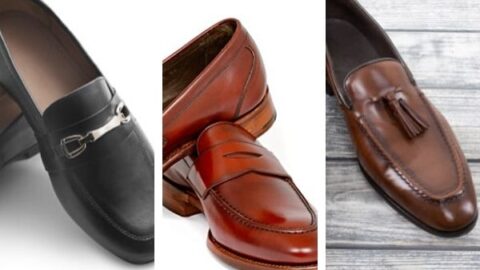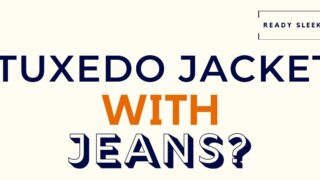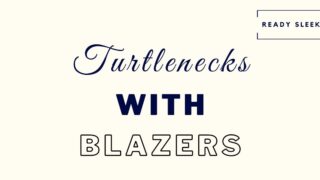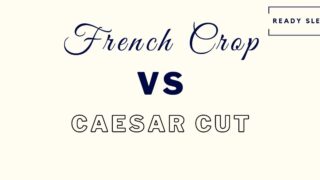This popular yet vague dress code can cause a huge amount of confusion. Its definition is so blurred that even those setting it often don’t fully understand it. Footwear is no exception. So, are loafers business casual?
Loafers are one of the most commonly worn shoes in business casual settings. It very effectively strikes a balance between casual and formal; a laid-back, slip-on design combined with the structure and heel of a more formal dress shoe. Loafers can differ in style, material, and color, and some will be more appropriate in certain workplaces than others.
Loafers will usually be a safe bet for this dress code. It’s almost as though they were made for it.
But it’s clear that some loafers look more casual, while others look more formal.
“Business-casual” can mean different things in different industries. Sometimes it’s more casual and sometimes more formal.
Underdressing with a pair of loafers is still a risk.
This article will teach you how to wear the right pair of loafers in different business-casual settings.
Let’s dig a little deeper.
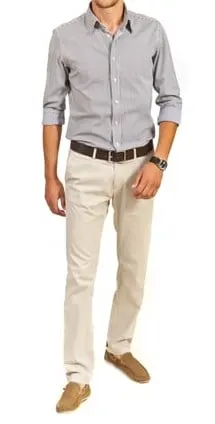
How To Wear Loafers As Business Casual
To wear loafers as business-casual, you’ll first need to assess what “business-casual” actually means in your particular setting.
Put simply, business casual usually means no suits and no jeans. It’s characterized by the combination of traditional business attire and casual apparel.
But as you’ve probably figured out, that’s not a great definition as there’s a lot to potentially choose from.
This is usually the hardest part. I find it helpful to split the dress code into two broad categories based on industry, as it’s quite likely that you’ll fit into one of them.
- Corporate / Professional – Think finance, law, accountancy, etc.
- Relaxed Office / Service – Think retail, marketing, design, etc.
You’ve also got ultra-modern workplaces and startups where anything goes, but it’s safe to say you’d be able to wear loafers in these too!
Let’s take those two main categories and talk through how you’d wear loafers as business-casual in each of them.
Corporate/Professional
Although these offices may state that their dress code is “business-casual”, it very often isn’t as “casual” as you may first assume.
You won’t need to wear a suit, but it’s worth clearing up what you do need to wear before you sort out your outfit.
In general, you’ll want to go for a smarter pair of loafers to be on the safe side. Go for dark brown leather; bit loafers would work a treat but penny or tassel loafers would be perfectly fine too.
Items you could wear them with:
- Navy blazers or dark-colored sports coats
- Chinos (classic business-casual attire)
- Tucked-in Oxford Button-Down or dress shirt
- Possibly a necktie
- Dress watch
Avoid jeans, polos, and of course, avoid suits.
For one, suits aren’t business-casual. Secondly, suits and loafers are hard to pull off. It can be done, but you’d need to go for a black pair of leather bit loafers if you really wanted to do it.
Relaxed Office / Service Industry
You’ve got more freedom here and it’s safe to say that any pair of loafers will most likely be fine.
But you still don’t want to risk underdressing.
To play it safe, go for a medium to dark brown pair of suede or leather loafers; any style will do (bit, penny, or tassel).
Don’t go too light or bright in color. Brown is always a good option for business-casual.
Items you could wear them with:
- Sweater or cardigan
- Long-sleeve polo or Oxford shirt
- Sports coat in a lighter color or with a gentle pattern
- N.B avoid layering over polo collars. I.e no sports coat
- Chinos
Again, avoid jeans.
Remember, there may be times when you want your business-casual outfit to be a little dressier. For example, when client-facing or attending meetings.
Remember this when choosing your outfit and style of loafer. Sometimes, a sports coat may be wise, while at others, a simple sweater or a shirt alone would be fine.
Which Loafers Can Be Worn As Business Casual?
There are three main styles of loafer you should be aware of. I’ve touched upon them already, but it’s important to understand exactly how they’re different.
Each of them would work great in business casual settings, but they do differ a little in terms of their formality.
Bit Loafers
Also known as “horsebit loafers” or “Gucci loafers”, they’re defined by the classic metal buckle on top of the vamp.

Shutterstock
It’s shaped like a horse’s bit; hence the name.
The bit loafer is considered to be the most sophisticated and elegant style of loafer you can buy.
If your business-casual setting leans more toward the formal side, for example in professional or corporate settings, a dark brown leather bit loafer would be a good way to go.
The sheen and eye-catching appearance of the metal makes it look a touch more refined than the other two on this list.
Sure, they still aren’t as formal as Oxfords or Derbys. But as far as loafers go, they look pretty sharp and are more than appropriate for all business-casual settings.
Penny Loafers
Penny loafers are arguably the most popular style of loafer in the world. They’re characterized by a leather strap across the top, often with a diamond-shaped cutout.
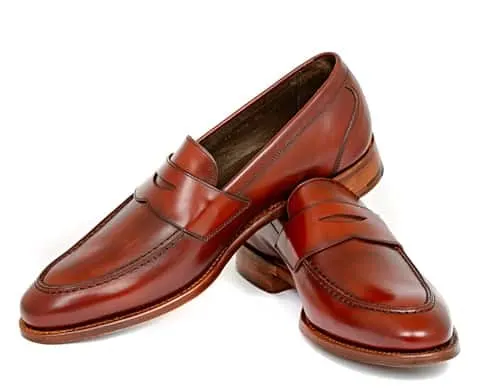
Shutterstock
They ooze a laid-back aesthetic while still being perfectly acceptable for business-casual outfits
They look a little more casual than bit loafers, so bear this in mind if you’re choosing between the two.
Tassel Loafers
These are about as formal as penny loafers but have a slightly more decorative appearance to them.
This is thanks to the front-and-center tassel on top of the vamp. It’s a very popular style of loafer, particularly among gentlemen above the age of 50.

Shutterstock
In fact, you’ll often find men within this demographic wearing tassel loafers together with their business suits.
Having said that, tassel loafers in more vibrant colors and suede finishes are popular with the younger generation too.
Much like penny loafers, they’d be acceptable in most business-casual settings. But if you were looking to go just a little more formal, opt for a bit loafer instead.
Suede Vs Leather Loafers For Business Casual
Suede loafers can be worn in business-casual settings, but are more appropriate in relaxed office environments than they are in corporate or professional workplaces.
In more formal office environments such as this, leather loafers usually work best. You may not need to wear a suit, but you’d still most likely be expected to dress up a little.
The finish of suede is softer and more napped than leather. This makes it look more casual, as it lacks an obvious sheen.

DepositPhotos
Certain suede loafers will look more casual than others.
For example, unlined suede loafers look more casual than lined suede loafers. This is because they’ll look less structured and more like a moccasin or slipper.
Suede bit loafers look a little more formal than suede penny or tassel loafers.
The same goes for leather loafers. Lined will look more formal than unlined.
Bear this in mind when choosing a pair for your specific occasion or setting.
What Color Works Best For Business Casual Loafers?
When you’re deciding on a color for your loafers, you’ll need to once again determine just how “casual” your “business-casual” dress code really is.
The color will play a huge role in determining just how formal or casual your loafers will look.
This rule applies regardless of whether we’re talking about suede or leather, or whether we’re talking about bit, penny, or tassel loafers.
Black will always be the most formal color, while dark brown will come a close second. Lighter and brighter colors and shades will always look more casual.
Black loafers may be a bit too formal for business casual outfits. They could still work, but aren’t ideal. Having said that, they’re also a bit too casual for formal suits.
That’s why black loafers really aren’t very versatile.
Brown loafers are excellent for business-casual outfits. They’re incredibly versatile and will make color matching and coordination so much easier.
If your business-casual setting leans more towards the formal side, for example in corporate offices, go for a dark brown.
In more relaxed office environments you have more choice. But to play it safe, go for a light to medium brown. Avoid bright or unusual colors if possible. At the end of the day you still want to come across as professional.
Are Loafers With No Socks Still Business Casual?
Wearing loafers without socks is considered too casual to be business-casual in almost all contexts and settings.
You should avoid doing it whenever possible.
Plus, loafers should always be worn with socks in any case. This is for the sake of hygiene, as well as comfort.
Unlike boat shoes, they weren’t designed to be worn without socks, and doing so can be quite uncomfortable.
With business-casual outfits, also avoid no-show or “invisible” socks.
Although you’d technically be wearing socks, the sockless appearance just comes across too unprofessional for most workplaces.
If you happen to work in an “anything-goes” setting where this doesn’t hold true, that’s fine. But it still probably isn’t worth the risk.
3 Core Principles Of Business-Casual Loafers
There are three principles that should be considered universal to all business-casual dress codes no matter what industry you work in.
Let’s see how they apply to loafers.
1. If In Doubt, Overdress
The vague nature of this dress code can be risky.
Underdressing isn’t the end of the world, but it can be frustrating. This is particularly true if you’re looking to make a good impression.
If you aren’t sure exactly how “casual” that “business-casual” dress code really is, overdress rather than underdress.
Let’s use an example.
You’ve got a new accountancy job and the office has got a business-casual dress code.
If you aren’t sure quite what that means at first, go for dark brown leather loafers as opposed to your regular suede driving loafers.
Go for a sports coat and maybe even a necktie. If you find that you’re overdressed you could always just take them off.
This principle applies to relaxed office environments and service industry jobs as well. If you aren’t quite sure, overdress just a little.
2. Business-Casual Varies From Day-To-Day
We’ve established that you can get a good idea of what “business-casual” actually means by assessing what industry you’re in.
This will give a pretty good grasp of what sort of clothing you’re expected to wear.
But it’s important to remember that although your overall dress code is “business-casual”, your job may sometimes require you to dress it up at times and also dress it down at times.
For example, board meetings/regional meetings may require a dark pair of leather bit loafers, but for your regular desk job you could get away with more casual suedes.
3. Dress Up When Meeting Superiors And Clients
Don’t get too carried away with the “casual” aspect of “business-casual”.
It can be misleading and quite deceptive.
Ultimately, you still want to come across as professional, while still enjoying the freedom and liberty that this thoroughly modern dress code does bring.
It’s clear that the way a man dresses can leave a bad impression with his superiors, colleagues, and clients.
As a general rule, if you know you’re going to be meeting or presenting to a superior or a client, dress up your business-casual outfit.
Wear dark leather loafers on those days instead of your chilled tan suedes.
This principle highlights the importance of planning ahead with your wardrobe. Stay organized and know what you’ll be doing and who you’ll be meeting on a day-to-day basis.
Conclusion
Don’t let this dress code fool you. As you’ve probably gathered by now, it isn’t as simple as it may first seem.
Having said that, it definitely isn’t rocket science either. Most loafers will work absolutely fine, but there are some which are more appropriate than others in certain settings.
Hopefully, this article has helped you figure out exactly what you’ll need to wear and when.
Ready Sleek founder. Obsessed with casual style and the minimalist approach to building a highly functional wardrobe. Also a fan of classic, vintage hairstyles.

